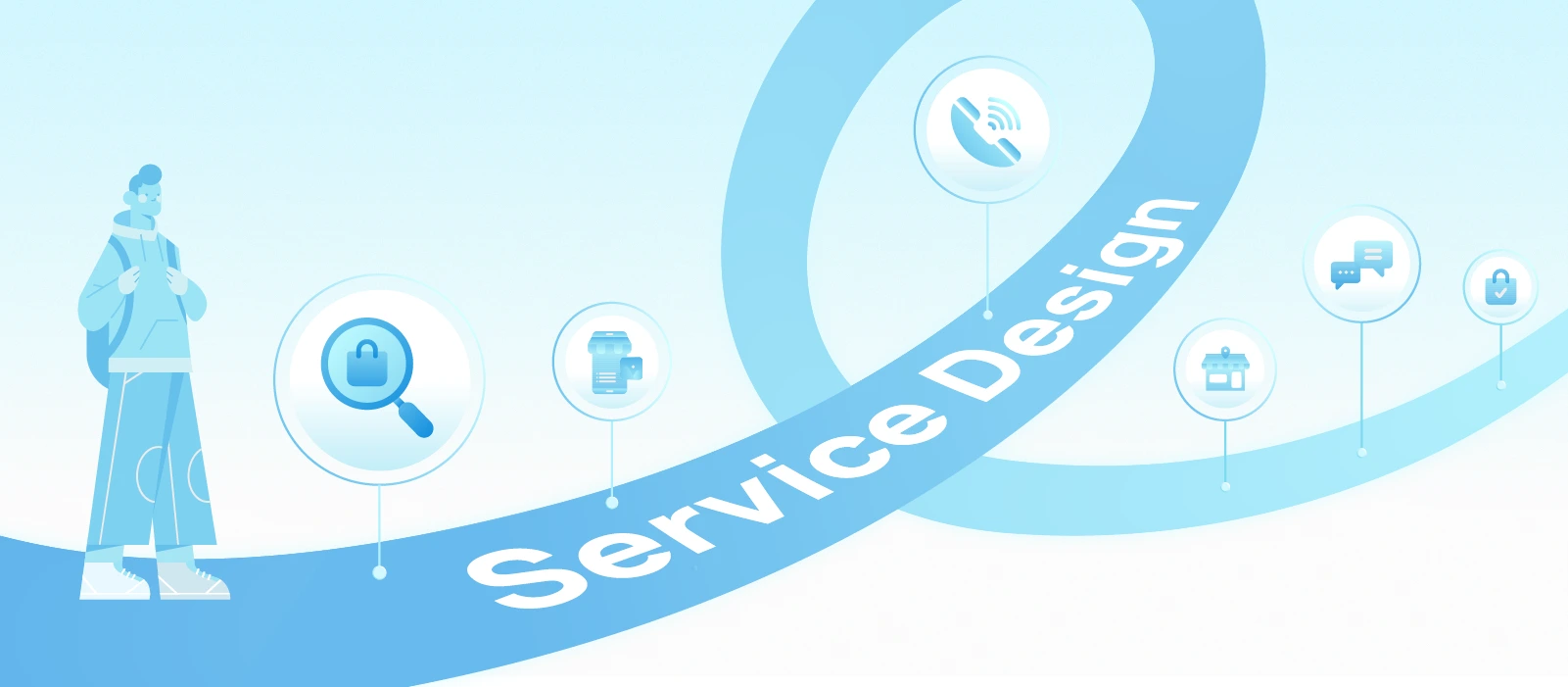UX UI Design Studio


As you enter the world of design, you might have encountered the term “UX” – denoting the overall User Experience while interacting with a product or service. Upon delving deeper, you would realize that understanding UX alone isn’t enough to guarantee smooth experiences throughout customer buying journey, but optimizing CX (Customer Experience) as a whole is required as well!
And at the time you find out about the existence of service design, have you ever got frustrated and wondered why there are so many design concepts in this world?
Take a moment to relax! Everything on Earth has a purpose! Let’s explore Service Design and how it relates to CX UX Design through our blog!
Service design takes a holistic approach to optimize the delivery of services. It involves understanding customer needs and designing the entire service ecosystem (including processes, touchpoints, interactions, and people) to align with those needs.
The work of service designers involves optimizing internal processes, policies, and structures to align both back-stage departments (e.g., IT, Finance, Accounting) and front-stage departments (e.g., Sales, Customer Service) with the specific needs of the customer.
A prominent example of service design is Starbucks! The brand focuses on creating a welcoming in-store environment, with well-designed layouts, cozy seating areas, and relaxing music. Starbucks also emphasizes personalized interactions, where baristas dedicate time to understanding customer preferences and crafting customized beverages. Given that, Starbucks has built a loyal customer base and created a distinct brand identity centered around the coffee shop experience.
In the service industry, service design thinking is crucial and can be the determining factor between success and failure for organizations. The service design thinking emphasizes the strategic organization of resources and the planning of business activities to enhance both consumer and employee experiences.
In the book “This Is Service Design Doing”, the authors outlined 5 core principles defining service design thinking:
To do service design best, designers need to empathize with both businesses and users/customers, define, iterate, and address all their problems holistically. Throughout this iterative process, designers employ various tools to aid their work, some of which some common tools include:
A persona is a fictional representation or reference model that represents a specific type of customer based on various characteristics. These characteristics can include Demographic characteristics (e.g., name, age, gender, occupation, etc.) or Behavioral characteristics (e.g., preferences, needs, motivations, goals, and pain points, etc.).
By creating personas, organizations can develop a deeper understanding of their customers and, hence, tailor their services to better meet customer expectations.
The journey map is a sequential description of a customer’s interactive journey with a service. It describes what happens at each stage of the interaction, what touchpoints are involved, and what obstacles and barriers they may encounter. It also represents the level of emotions (positive/negative) that customers experience throughout the interaction.
A service blueprint is a diagram that maps out the entire process of service delivery, listing all the activities that happen at every stage above and below the line of visibility. The service blueprints help visualize all of the components of service encounters:
UX (User Experience) refers to the overall experience a user has when interacting with a product/service. UX Design (User Experience Design) takes into account all aspects of user interaction, including usability, ease of use, and overall satisfaction,…
Meanwhile, CX, which evolved from UX, is a broader concept!
CX (Customer Experience) encompasses the overall interactions that a customer has throughout their journey from pre-purchase to post-purchase stages. CX strategies aim to wow customers at every point of their journey, keeping them engaged with the brand through impactful interactions. The strategies must involve every product/service like brand packaging, apps, websites, the buying experience, staff interactions, and the overall ambiance and aesthetics of offline touchpoints like stores.
Do you know about:
To understand the differences between the scope of CX vs UX Design, let’s explore the three levels of experience, described by Nielsen Norman Group.
First, the interaction-level experience involves designing the user experience of a single interaction to perform a task. Most UX designers work at the interaction level by designing interfaces on digital products (websites/apps) or across physical touchpoints, making sure every tap, click, or swipe feels smooth and user-friendly.
Examples of interaction-level design work: Adjusting button color/position/size to enhance attractiveness and usability, or incorporating gestures (such as swipe, pinch-to-zoom, or drag-and-drop,…) to make interactions more intuitive for touch-based devices.
Moving up a level, the journey level refers to the entire end-to-end process or sequence of interactions a user has with a product, service, or system to complete a goal over time. This process may involve multiple devices and interaction channels (e.g., websites, apps, email, online chat, social platforms,…).
Examples of UX work at this level: Designing user flow for a flight/accommodation booking, online course enrollment or job application process.
At the relationship level, the dynamic between customers and the brand transforms into a lasting connection. Extending beyond single interactions and journeys, this level concentrates on the overarching relationship and its evolution over time. CX designers focus on sculpting the entirety of a person’s experience with an organization, prioritizing the lifetime journey over merely evaluating the quality of a single interaction or journey.
Some examples of CX work at the relationship level, include:
Note: Interaction-level UX impacts the journey-level experience, and collectively, they shape the relationship-level experience. Each holds its significance with unique constraints and objectives, therefore, no single level takes precedence over another.
While UX tasks operate at the interaction and journey levels, CX Designers handle responsibilities at the relationship level. This illustrates the expansive scope of CX in comparison with UX. Some may perceive CX as a broader domain that encompasses numerous UX tasks (just like 3=1+1+1). However, certain CX works do not involve UX Designers, such as Developing brand identity, Building Customer Relationships,…
Check out this blog:
It’s crucial to understand that the distinctions between Service Design, UX, and CX Design are not black and white, and there are some overlaps among them.
You may want to read more: What is a Design Audit? How to conduct an effective Audit?
To imagine how UX, CX Design and Service Design work in practice, let’s break down an example within the context of a customer’s journey to purchase new clothes.
Once again, the works of CX UX Design and Service Design somehow overlap, and it’s impossible to completely separate them from each other. Through this blog, hoping that you have clarified the distinction between each term!
And if you’re planning to develop a digital product (website/app/management system) that supports creating an optimized and thoughtful customer experience, we are here to guide!
We are Lollypop Design Studio – A Global UI/UX Design Agency, crafting impactful designs and local digital experiences for the USA, Japan, Vietnam, and other parts of the world. We are ready to leverage your business, contact us for a free consultation on your project!

